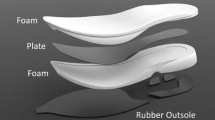Summary
Eight soldiers on skis transported three loads of different weights on the level, uphill and downhill. The load was placed either on a cargo sledge or in a backpack or divided between the sledge and the backpack. The sledge had a new type of haulage-shaft, which was fixed to both sides of the pelvis. A service belt spread the pull over the whole upper body. The physical strain of different transport methods and the serviceability of the sledge was studied by measuring heart rate (HR), oxygen consumption, ventilation, and perceived exertion. The results indicate that both absolute and relative strain were systematically lower when pulling the load on the sledge than when carrying it in the backpack and on the sledge. HR when pulling a load equal to the human body weight on the sledge was on average 133 beats · min−1; HR was significantly higher 144 beats · min−1 when the load was divided between backpack and sledge. At the lower load level the differences between the transport methods were not significant for HR, oxygen consumption or ventilation. Uphill travel increased oxygen consumption by about 50% over that on the level. Perceived exertion at all load levels was significantly lower with the sledge than with the backpack alone or in combination. The estimated maximal allowable working time emphasized the advantage of the sledge and the importance of high physical working capacity. The manoeuvrability of the sledge with the new haulage shaft was good and the braking mechanisms worked well. The results imply that a man with normal working capacity is able to transport a load equal to his own weight for about 2.5 km without overstrain by pulling it an a sledge on the level. This result is valuable for the planning of field medical services.
Similar content being viewed by others
References
Andersen K, Rutenfranz J, Masironi R, Seliger B (1978) Habitual physical activity and health. World Health Organization, Copenhagen. WHO regional publications: Eur SeriesNo. 6
åstrand I (1960) Aerobic work capacity in men and women with special reference to age. Acta Physiol Scand [Suppl 169] 49
Bink B (1962) The physical working capacity in relation to working time and age. Ergonomics 5:25–28
Bonjer FH (1962) Actual energy expenditure in relation to the physical working capacity. Ergonomics 5:29–31
Borg G (1970) Perceived exertion as an indicator of somatic stress. Scand J Rehabil Med 2–3:92–98
Deivanayagam S, Ayoub MM (1979) Prediction of endurance time for alternating workload tasks. Ergonomics 22:279–290
Ekblom B, Goldberg AN (1971) The influence of physical training and other factors on the subjective rating of perceived exertion. Acta Physiol Scand 83:399–406
Ilmarinen J, Louhevaara V, Oja P (1984) Oxygen consumption and heart rate in different modes of manual postal delivery. Ergonomics 27:3:331–339
Keren G, Epstein Y, Magazanik A, Sohar E (1981) The energy cost of walking and running with and without a backpack load. Eur J Appl Physiol 46:317–324
Lind AR, McNicol GW (1968) Cardiovascular responses to holding and carrying weight by hand and shoulder harness. J Appl Physiol 25:261–267
Lippold OCJ, Naylor PFD (1950) The design of load carriage equipment for the soldier in battle order. A.O.R.G. Rep 11/50. War Office, London
Louhevaara V, Ilmarinen J, Oja P (1980) Comparison of the åstrand nomogram and the WHO extrapolation methods for estimating maximal oxygen uptake. Scand J Sports Sci 2:1:21–25
Louhevaara V, Ilmarinen J, Oja P (1985) Comparison of three field methods for measuring oxygen consumption. Ergonomics 28:2:463–470
Myles WS, Saunders PL (1979) The physiological cost of carrying light and heavy loads. Eur J Appl Physiol 42:125–131
Robertson RJ, Caspersen CJ, Allison TG, Skrinar GS, Abbott RA, Metz KF (1982) Differentiated perceptions of exertion and energy cost of young women while carrying loads. Eur J Appl Physiol 49:69–78
Rutenfranz J, Seliger V, Andersen KL, Ilmarinen J, Flöring R, Rutenfranz M, Klimmer F (1977) Erfahrungen mit einem transportablen GerÄt zur kontinuierlichen Registrierung der Herzfrequenz für Zeiten bis zu 24 Stunden. Eur J Appl Physiol 36:171–185
Author information
Authors and Affiliations
Rights and permissions
About this article
Cite this article
Juhani, I., Pekka, S. & Timo, A. Strain while skiing and hauling a sledge or carrying a backpack. Europ. J. Appl. Physiol. 55, 597–603 (1986). https://doi.org/10.1007/BF00423203
Accepted:
Issue Date:
DOI: https://doi.org/10.1007/BF00423203




